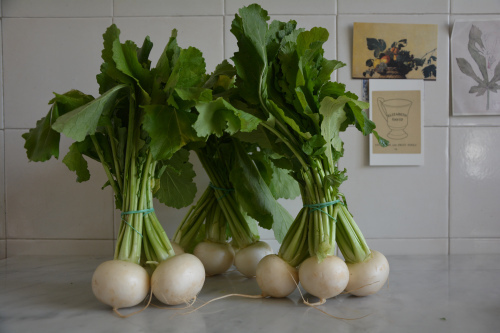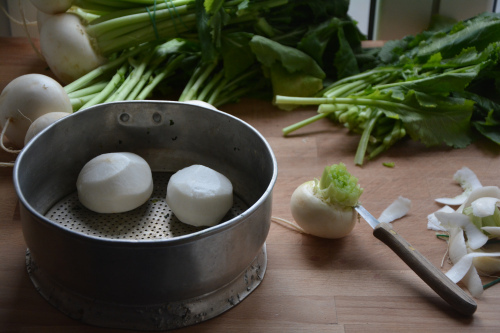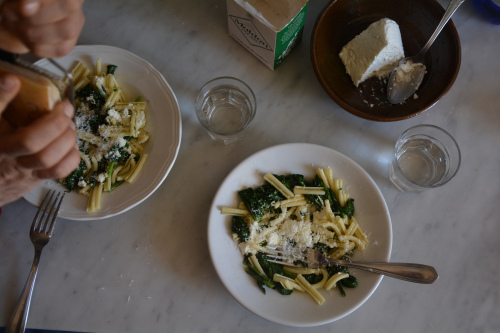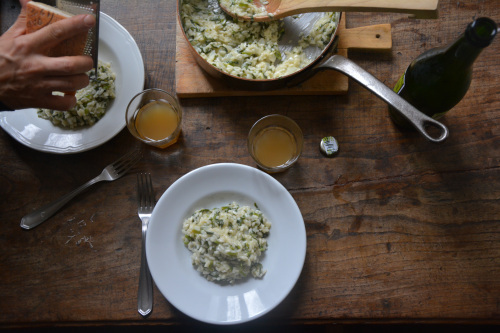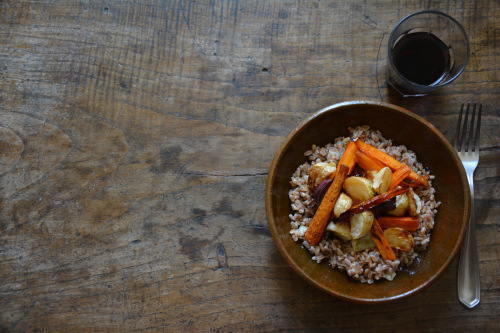no laughing matter
‘Oh dear‘ said a friend when I told her I was going to write about turnips. ‘Does anybody actually like them?’ I was about to say I do, but she was off on a beetroot and radish tangent before changing the subject entirely, so I just nodded. Afterwards it crossed my mind she was probably referring to the early winter variety, stout, purple-tinged turnips which, if left too long, can become stringy and harsh, which is where the ridicule comes in I suppose. ‘What is the difference between turnips and snot? Children will eat snot‘ was the joke David Stott told us in the playground. We rolled about laughing until our seven-year-old sides hurt. The giggles were carried into the school dining room where waterlogged turnips mashed with carrots and cheap margarine were shunted around our plates.
Catch them before they turn though, and winter turnips can be excellent, especially roasted, creamed with potatoes and butter or, as I once ate in France, glazed to serve with ham. It is not the early variety we are taking about today though, but late winter/early spring turnips, white spheres with a soft matt glow, bunched together by their bright green leaves.
‘Three more, bunches?’ checked my faithful fruit and veg man at my local market here in Testaccio in Rome. ‘What are you doing with all these turnips?’ Then he laughed as if there might be turnip funny business, in which moment he looked just like his heavy-browed, twinkly-eyed dad, my other fruit and veg man. ‘Don’t forget to eat the leaves‘ he said stuffing the bunches in a bag in the same way I shove laundry in the basket when I am cross, and before I could say please be careful I need to take a picture. ‘‘ ‘Ste cazzo de foto!’ he said laughing even harder.
Turnip leaves, or turnip tops as we call them in England, are an excellent green vegetable reminiscent of mild mustard greens with their slightly peppery warmth. Romans love them, particularly cooked twice, which we will come to shortly. The turnips themselves are crisp and sweetly peppery, and – as I have discovered in this last month of turnip cooking – are surprisingly adaptable, making wonderful soup, risotto and pickles. They are also good roasted, which prompted Vincenzo to remind me – for the umpteenth time – that turnips were one of the earliest cultivated vegetables, and an important food for the Ancient Romans. There is also the story of the Roman war hero Curius Dentatus who, at the start of the third century, refused a large amount of gold to defect to the side of Hostile Samnites because he was busy roasting turnips over a fire.
When choosing turnips look for bright, lively leaves and smallish white bulbs. Like people: avoid those that are too bloated, faded or smell too strongly. Young turnips only need a very thin layer peeling away. Their greens however are as good as three-year-old boys at hiding mud and grit, so give them a damn good wash. Now get cooking, and remember, turnips are no laughing matter. Snigger.
Pasta with turnip greens and ricotta
One of the most useful and delicious things I have learned since living in Rome is to ripassare greens. It means to cook twice, first boiling briefly and then re-cooking in a skillet with garlic scented olive oil. The greens can then be served as a side dish, or mixed with pasta for a quintessential southern Italian dish. Turnip greens, with their slight bitterness, work beautifully ripassata and mixed with pasta, especially orecchiette, or little ears. The key is a generous amount of good extra virgin olive oil, never letting the garlic burn and making sure the greens are glistening. I also like a blob of ricotta and a dusting of parmesan or pecorino on the finished dish.
serves 4
The greens from two bunches of turnips
salt
5 tbsp extra virgin olive oil
2 cloves of garlic
450 g short pasta, ideally orecchiette
Ricotta (optional)
parmesan or pecorino
Wash and dry the turnip greens. Roll them into a loose bundle and chop roughly.
Bring a large pot of water to a fast boil, salt generously (the rule of thumb is 1 litre of water/ 10 g salt for every 10o g of pasta) and stir. Add the greens, boil for a minute then use tongs or a slotted spoon to lift them from the water, drain and set aside.
Now tip the pasta to the pot, set the timer and cook until al dente.
Meanwhile, peel and gently crush the garlic cloves with the back of a knife so they are split but still intact. Warm the olive oil and garlic in a large skillet over a medium/low flame until the garlic is fragrant (be careful it doesn’t burn) add the greens and a pinch of salt and toss and turn until they are glistening with oil. Turn off the flame
Once the pasta is cooked, drain it – saving a little of the pasta cooking water – and tip onto the greens and toss. If it seems dry, add a spoonful of pasta cooking water, and toss again. Divide between warm bowls topping with a blob of ricotta if you wish and finishing with parmesan or pecorino.
Pickled turnips
Apparently my mum craved pickles when she was pregnant with me, which might explain my extreme enthusiasm. I only wish I had known sooner that DIY pickling was so easy. Since learning this simple technique I have pickled cauliflower, beets, carrots, radishes and – best of all – turnips. It is something about the crispy, peppery sweetness sharpened by spiced vinegar that hits the pickle spot. I am not very discerning and would eat these with anything, but particularly cured and boiled meat, strong cheese, savory tarts, in sandwiches like a sharp chutney and beside rice and beany concoctions. Some people like to add a beetroot to the mix to give a pleasing pink tint. I had intended to do this, but forgot to buy one.
1 cup /250 ml water
4 tbsp / 40 g coarse salt
3 tbsp / 30 g sugar
2 bay leaves
5 black peppercorns
1 cup / 250 ml white wine vinegar
1 llb / 500 g turnips (which is usually the bulbs of two bunches)
1 small beetroot (optional)
Put the water, salt, sugar, bay leaves and peppercorns in a pan, over a medium flame and warm until the salt and sugar have completely dissolved. Remove from the heat and allow to cool.
Add the vinegar to the pan. Wash a jar with very hot water and in a warm oven so it is sterilized.
Peel the turnips and beet, then cut into 3 mm or so wedges. Put the wedges in the jar, cover with the liquid. Seal and leave for at least a day and up to a week. Once opened, store in the fridge.
Turnip soup with garlicky turnip greens
I learned to write recipes whilst helping my friend and chef Mona Talbott with the American Academy in Rome soup book some years back. Every Sunday morning for seven months, we would meet in the Academy kitchen, drink coffee, then begin: Mona cooking, me noting quantities and details. Then we both ate soup. At the end of the day I would walk down the curving Gianicolo hill, several mason jars filled with soup clinking in time with my every step. This soup was one of my absolute favourites. It is a pure, simple and smooth soup which – to me – feels like the essence of turnip with a pleasing hint of aromatic, herbal bay. Into the pale soup, you swirl dark green turnip greens which have been wilted in olive oil and garlic, which elevates the soup to a whole new level of taste and texture. The key is patiently sweating the water out of the turnips before you add more liquid. If you like a more decisive stronger flavour use stock. Garlic rubbed/olive oil soaked toast is nice with this.
serves 4
2 lb / 1 kg turnips with greens
a small potato
2 medium onions
3 tbsp extra virgin olive oil
a knob (2 tbsp) butter
1 liter water, vegetable stock or light chicken stock
2 bay leaves
salt and pepper
for sautéing the greens – 3 tbsp extra virgin olive oil and a clove of garlic
Strip the greens from the turnips and set aside. Peel the turnips, potato and onion and slice thinly.
Warm 3 tbps olive oil and the butter in a large, heavy based pot over a medium low heat. Add the onion and sweat until soft and translucent, about 5 mins. Add the turnips, potatoes and a pinch of salt to the pot, and continue cooking for 10 minutes, stirring every now and then, allowing the turnips to soften and sweat off some liquid.
Add the liquid and bay leaf to the pot, bring the soup to the boil and then reduce to a simmer for 15 mins. Remove the bay leaf, the use an immersion blender to reduce the soup to a smooth puree. Season with salt as required.
Wash the turnip greens and dry them. Roll them into a bundle and then chop roughly. Peel and gently crush the garlic with the back of a knife.
Warm 3 tbsp olive oil and the clove of garlic in a sauté pan over a medium/low flame. Once the garlic is fragrant and just starting to colour (it must not brown or will be bitter) add the greens and sauté them until they are wilted and glistening with olive oil. Remove the garlic and then tip the greens into the soup and stir. Serve with a grind of black pepper and a swirl of olive oil.
Turnip risotto
Risotto was suggested by another stall holder at Testaccio market. I was wary. Then I tried, and was surprised and delighted by the delicate, vegetal and ever-so-slightly-peppery risotto that came together one grey Wednesday lunchtime in Rome in February. I suppose you could argue that any vegetable sautéed and oil and butter, given body by plump rice and whipped into creaminess by a mantecatura of butter and parmesan cheese is going to be good. As with the soup above, if you are worried about intensity of flavour, use stock. If you are just two, still make enough for four: the remaining risotto can be moulded into balls, rolled in breadcrumbs and fried to make arancine.
serves 4
3 tablespoons olive oil
a walnut sized knob of butter
a small onion
3 turnips, ideally with greens
400 g risotto rice
100 ml white wine
1 litre of water, veg or chicken stock
50 g grated parmesan cheese
30 g butter
Strip the greens fron the turnips. Scrub the turnips (only peel them if you feel it is necessary) and dice them. Wash the greens, dry them, roll them into a loose bundle, then chop the roughly and set aside.
Warm the stock in a small pan and keep warm at the back of the stove. Peel and finely chop the onion. In a large, deep frying pan, warm the olive oil over a medium flame, add the onion and cook it for 3 minutes or so. Add the diced turnip and sauté for another 2 mines. Add the rice and stir until every grain is coated with oil, add the wine, which will woosh and evaporate.
Now look at the clock – this will take about 17 minutes so pour yourself a glass of wine – start adding the stock ladleful by ladleful, stirring all the time, only adding the next when the previous one is absorbed. After 10 minutes add the turnip greens and then continue with the stock. Once all the stock is absorbed and the rice is plump and creamy, pull the pan from the heat and wait one minute. Then add the butter and parmesan and beat everything together with a wooden spoon (this beating is called the mantecatura and it is what makes a risotto so beautifully creamy).
Roasted turnips, carrots and red onions with farro
I am not sure if I would turn down a lots of gold for them, but I do like roasted turnips very much. As is the case with so many vegetables, roasting turnips means water evaporates and the natural sugars and flavours are concentrated. The turnips, red onion and carrots should shrivel slightly, crisping and curling at the edges. Farro, another ancient and modern Roman staple, provides a tasty, nutty, no-nonsense base. I feel as if I could march a very long way after eating this. It is also delicious. I have been known to top this with a poached egg or crumble over feta cheese. Ideally you want to keep a portion for the next day, when it is even better
This post was at the suggestion of the brilliant food community food52, where I am also sharing – a slightly shorter version – of this post. This final recipe will be on Food52 site in the next couple of weeks. I will put up the link as soon as I can. – R


Rachel Roddy's Blog
- Rachel Roddy's profile
- 14 followers


